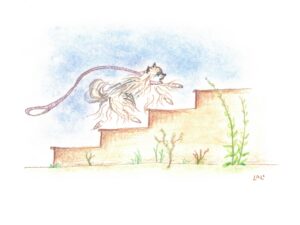You can’t rush things with Truffle, my rescue-Pomeranian-who-spent-7 1/2 years-in-a-cage. It took weeks for him to make eye contact with me, and months to look anyone else in the eye. But having learned that sometimes people give him treats, he has developed a compelling stare that brings strangers to their knees. It also took him a while to learn to walk in a straight line. During his caged life, he developed the habit of running constantly in circles, in the manner of lions and tigers caged in not very nice zoos, and on our early walks together he could only progress by spiraling around my ankles as we went. How I kept from bashing my face against the pavement is a kind of miracle. Now on cool, bright mornings he trots so fast that it’s all I can do to keep up with him.
For a long time, he wouldn’t do stairs, recoiling in horror whenever I encouraged him to try. If, God forbid, I did something extreme, like give the merest tug on the leash, it would send him careening in the opposite direction. This was not a huge problem, since I could scoop him up and carry him. Still, I didn’t want to turn into one of those little old ladies who carry their (often snarly) micro canines in their arms like babies. But how to teach him to go up the stairs? Treats and pleadings did not work. If he even saw me stop at the foot of the stairs and turn my eyes in his direction, he would balk.
Then one day, when I was thinking about something else, I happened to put one foot on the lowest rung without looking at him, and he flew up the entire flight, reaching the top before I did. We have tried other staircases since, and he shoots up them all, barely touching the treads, but always on the condition that I pretend that he isn’t there.
Going down the stairs, however, is a different story. How many times have I sat on the top step and tried to lure him with bits of kibble to go down just one step, only to have him back away, his eyes (one blue, one brown) wide with panic. I had just resigned myself to carrying him down the stairs for the rest of his life, when the universe sent me an inspiration: this time, instead of sitting down on the top step, I sat down on the bottom step, set him on it, and offered him a treat if he jumped to the ground. Not only did he immediately jump down, in his excitement he then went up, and down, two whole steps.
But we’re still in the proverbial woods, Truffle and I. There is no guarantee that, if I set him down three steps from the bottom, he won’t panic, and then we’ll be back where we started from. But have learned my lesson. This week I’ll work on having him go down just two steps from the bottom. If all goes well, the week after that we’ll work on three steps, and so on. Maybe he’ll surprise me by deciding that stairs are not the devil’s playground, and one day he’ll float down them like he does going up.
The success of starting from the bottom instead of the top step made me wonder what other obvious, simple tricks are out there that would make it easier for Truffle to learn stuff. But for now I am content. Not only is he going up the stairs, but I am learning important lessons too. I’m learning to be patient, to set conservative goals, and to rejoice over the tiniest bits of progress. And this, come to think of it, is not just a good way to work with a damaged dog, but a recipe for living a reasonably happy life.



6 Responses
If I haven’t recommended it before, a great little book is “Don’t Shoot the Dog,” from Dr. Karen Pryor, which gives you everything you need to figure out little behavior oddities and problems.
And she has a lovely section about using some of the methods – on humans.
Thank you, Alicia. I will check it out. I haven’t read a good dog book in a long time.
Yeah Truffles and Lali
🙂
We see you walking Truffle on Crabapple where we live and now have a deep appreciation for how much you and his walks in the neighborhood mean to him after over 7 years in a cage—deeply moving.
Lovely to hear from you, Jan. I hope you can meet Truffle soon—he’s getting better at greeting strangers.